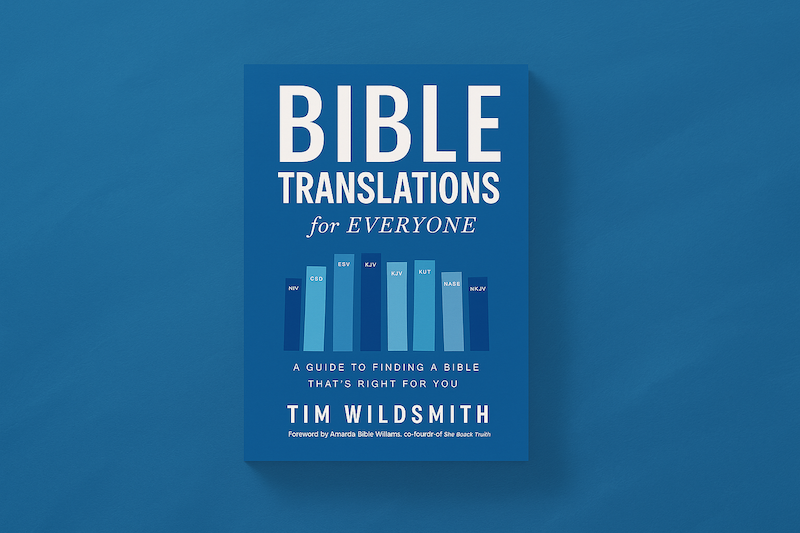
If you’re trying to choose the right Bible translation for your life and ministry, Bible Translations for Everyone by Tim Wildsmith offers a clear, practical guide—and this post reviews not only why it’s a resource worth having, but I also try to share five key takeaways to help you make informed and intentional choices about your Bible reading and teaching.
Released in 2024 by Zondervan Reflective, Bible Translations for Everyone by Tim Wildsmith serves as a practical guide to finding the Bible that’s right for you. It also walks through bible translation philosophies, publishers, and history. Wildsmith, known for his popular YouTube channel, has built a following of over 213,000 subscribers through more than 1,200 videos that explore various bible editions, translations, and features (from Thin line to Premium). As a book, Bible Translations for Everyone, includes a foreword by Amanda Bible Williams, co-founder of She Reads Truth, and has received praise from notable voices such as Mark Ward and Annie F. Downs. With extensive experience and a clear approachability, Wildsmith brings his passion for Scripture and his podcast experience to readers seeking to understand better Bible translation and the philosophies of modern and historic translations, as well as explore translation history, so that they can find the perfect Bible for their journey. Wildsmith started his YouTube channel, as he realized the closing of retail brick-and-mortar stores made it “rather difficult to see all these different kinds of Bibles in person before you buy one. So a few years ago, I started creating Bible review videos to help people get a better idea of what a Bible has to offer so they could make an informed purchase.” His channel does a good job at this, though may unfairly focus more on premium bibles than anything else of late.
If you’ve been reading the Lead a Quiet Life blog on Patheos for any length of time, you know this space is devoted to exploring what it means to lead a quieter life at a slower pace—to discover a simple life and faith that embraces downward mobility in a chaotic world and a church often obsessed with excess. So, you might be wondering how a review of Bible Translations for Everyone fits into that conversation. At the heart of leading a quiet life is living dependently on God and the sustaining presence of the Spirit. And it is through the Scriptures—first and foremost—that we come to know who God is and what it means to live quietly, to work with our hands, and to live in a way that is not dependent on the noise or approval of others. For those committed to living simply and intentionally—with a grounded understanding of Scripture—this book offers a valuable and practical resource.
What Bible Translations for Everyone Covers
At just about 170 pages, Bible Translations for Everyone features a foreword and introduction, followed by 15 concise and informative chapters. The book begins with an overview of the basics of Bible translation, introducing key concepts such as the textual basis—referring to which Hebrew, Aramaic, and Greek texts are used in translating the Old and New Testaments. We are blessed to have many textual bases to work from, and as Wildsmith points out, “Once the textual basis is set, the process of translation begins. If you ever took a foreign language class in school, you know how hard it can be to sync up the way your brain thinks in your native language to the way you speak or write in another language…we have to consider word order or syntax, and make sure that we flip things around for it to make the most sense.” That is why this chapter also explains the various translation philosophies, including formal equivalence (literal), functional or dynamic equivalence (thought-for-thought), and paraphrase. Wildsmith notes that this spectrum is not always as simple or helpful as it may appear in a chart. The author points this out himself, stating “I am not a huge fan of these types of charts, mostly because I think they tend to be more of a distraction than an aid. There has never been any sort of universal agreement on where each individual translation should appear on the spectrum or how this should even be determined.” He does try to develop a chart that he feels conveys a fair spectrum. This chapter on translation philosophies concludes by highlighting the role and background of the translators themselves.
The second section explores the earliest English Bible translations, beginning with figures like John Wycliffe, William Tyndale, Myles Coverdale, and Henry VIII, and tracing developments through the Geneva Bible, Bishop’s Bible, Douay-Rheims Bible, and others. Wildsmith then devotes the next ten chapters to the most widely known and used Bible translations today: the King James Version, Revised Version (and American Standard Version), Revised Standard Version, New American Standard Bible, New International Version, New King James Version, New Revised Standard Version, New Living Translation, English Standard Version, and the Christian Standard Bible. Each chapter provides an overview of the translation’s background, textual basis, philosophy, contributing scholars, and unique features. Sample verses are also included to help readers compare styles.
Chapter 13 highlights a selection of additional translations that Wildsmith believes are worth mentioning, such as the New English Translation, The Message, Legacy Standard Bible, Revised English Bible, Modern English Version, Common English Bible, and more. Chapter 14 focuses on Catholic Bible translations. All of these discussions lead to Chapter 15, “Finding a Bible That’s Right for You,” where Wildsmith offers guidance on how to choose a translation and suggests assembling a ‘team’ of three go-to versions to enhance understanding of any passage. Wildsmith remarks, “use what you’ve learned in this book to build your own “team” of Bible translations that complement one another, and then develop the habit of regularly reading and studying from all of them.” He suggests teams such as the ESV, NIV, and KJV’ or the NLT, NASB, and CSB.
The book concludes with acknowledgments, notes, key terms, a textual basis comparison chart, a Bible translations timeline, recommended reading, and the required scripture permissions. With deep experience and a highly accessible style, Wildsmith skillfully unpacks the history and philosophy of Bible translation, helping readers find the right Bible for their journey. This section proves that Wildsmith is not just making academic conversations understandable, but he is also back them up with scholarly research and credit.

Who Is Tim Wildsmith?
Tim Wildsmith holds a Master of Divinity from Fuller Theological Seminary (2020) and completed his undergraduate studies at Belmont University. Following his graduate work, he served as a visiting scholar at Wycliffe Hall, part of the University of Oxford. With over two decades of ministry experience, Wildsmith has become widely known through his social media platforms, where he reviews Bible editions, translations, and features—content that, according to the back cover, has been viewed tens of millions of times. Wildsmith also serves as the Assistant University Minister and Director of Missions & Outreach at Belmont University in Nashville (Tennessee), where he also teaches on understanding the bible as an adjunct professor in the School of Theology and Christian Ministry. He lives in Nashville with his wife, Becca.
Why I Picked Up This Book
I began reading Bible Translations for Everyone, first because I’ve long enjoyed Tim Wildsmith’s engaging and informative YouTube content, especially his videos and shorts that explore various Bible editions and translations. Also, I was driven to this book because these conversations around translation methods, history, and philosophies are ones that many of us have while attending seminary or Bible college, but much of that information fades with time, and as we settle into our favorite translations. With Wildsmith’s book, I wanted a clear, accessible resource that revisits the basics of Bible translation, explores its rich history, and critically analyzes the philosophies behind today’s most popular versions. In my role at Water Street Mission, I’ve been working to develop a guide for helping guests experiencing homelessness choose a Bible that meets their needs. At River Corner Church, I’ve also wanted to help our community better understand the significance of using a trustworthy translation. This book was an incredibly helpful tool on both fronts and as a thorough and concise resource.
Strengths, Gaps, and Honest Reflections
The book is written in everyday English, and explains some big concepts in easy to grasp ways. Wildsmith points out that more than anything he hopes it inspires readers to “engage with the enduring word of God in new ways.” Without a doubt, there are “many types of Bibles…available to you.” It is essential for us to know how to discern what Bible translation will be best for us, and for the contexts we serve, because the scriptures are “God-breathed and is useful for teaching, rebuking, correcting and training in righteousness” (2 Timothy 3:16). I wish this book would have included the God’s Word Translation (GW), addressed the way the ESV crowd is quickly becoming like the KJV-only crowd, and that he would have discussed why certain theological camps lean towards one translation specifically. Perhaps those are not everyday resources needed by the common individual, but they would help to bring a discerning awareness in church attendees. Wildsmith walks a compassionate way through all of these chapters, remaining unbiased and unaffiliated with any particular camp, but shares transparently about his own journey and convictions when needed. Wildsmith gives a fair look at the most popular translations of our day, and what their story and processes are, because “we can’t ignore when and where these people were doing their work. The historical events taking place during the translation process influence so much of the story behind each translation.” To me, this is the strength of Wildsmith’s work and this resource, he looks at the when and where, the events, and the scholars that shifted and shaped each translation of the bible we have today.
Five Practical Takeaways You Can Use Right Now
There are some very important takeaways from this book, practical guidance that can even be enacted right here and now, regardless if you have read the book or not.
- Choose your Scripture translation intentionally. Your Bible should be a trustworthy companion—one you can rely on and understand. Choose a translation that not only communicates clearly in your everyday language but also faithfully conveys the intent, meaning, and original verbiage of the passage. Don’t just go with what’s trendy or familiar; invest in a version that deepens your connection to God.
- Comprehend translation philosophies. Every translation is shaped by the philosophy and convictions of its translators. Whether formal equivalence (word-for-word), dynamic equivalence (thought-for-thought), or paraphrase, it’s important to understand how these approaches influence wording, tone, and theological nuance. No translation is without bias, it’s the work of scholars with theological convictions, so knowing the background helps us read with discernment and humility.
- Create a Bible translation “team.” Don’t rely on just one translation or version. Use a “team” of translations to compare and deepen your understanding of Scripture. At Water Street Mission, I preach from the God’s Word Translation (GW), but my study includes the NKJV, KJV, NASB, and NIV. At River Corner Church, I preach from the NIV but compare it with the NASB, NET, and NRSV/NRSVUE. Each version brings out different shades of meaning that enrich our grasp of the text.
- Confidently stand on the thorough work of scholars and translation organizations. Books like Bible Translations for Everyone remind us of the rigorous scholarship behind major translations. While some may critique versions like the NIV, we shouldn’t overlook the fact that it—and others like the ESV—were developed by teams of over 100 scholars with deep reverence for God and Scripture. Rather than dismissing translations, let’s appreciate the faithful labor that brought them to life.
- Converse more on translations. We need more honest, informed conversations about Bible translations—not fewer. Our communities benefit when we understand the strengths and limitations of different versions. While some translations (like The Passion Translation) raise valid concerns due to questionable translation methods, we’re blessed with many solid options. Mentioning comparisons in sermons, explaining why your church uses a certain version, and acknowledging each translation’s weaknesses helps prevent idolatry. When we elevate one translation as untouchable—like the preacher who claimed the KJV could correct the Greek—we close ourselves off from the fullness of God’s Word.
Final Thoughts: A Valuable Resource for Every Bible Reader
Please note, the most important translation you can read, is the one you are going to commit to. Secondly, allow the scriptures to transform your life. However, this doesn’t take away from being smart about which translation you read. This book isn’t just for academics or Bible collectors—it’s a practical companion for anyone who wants to quietly, faithfully, and thoughtfully engage God’s Word in everyday life.
To me, Bible Translations for Everyone is an essential resource for anyone seeking to better understand how and why we have so many English translations of the Bible today. I think it would be a good resource to study with others. This is a book you keep on your shelf in near reach when someone asks you a question about a certain translation. Regardless if you are a pastoral leader, seminary student, Bible study leader, or simply a bible reader trying to better understand your bible and choose translations for personal reading, this book offers unmatched background story, historical clarity, and practical guidance. I recommend using it not only to inform your personal Bible selection but also as a teaching tool in discipleship groups, church workshops, or introductory courses on Scripture—helping others approach the scriptures with both confidence and curiosity.














